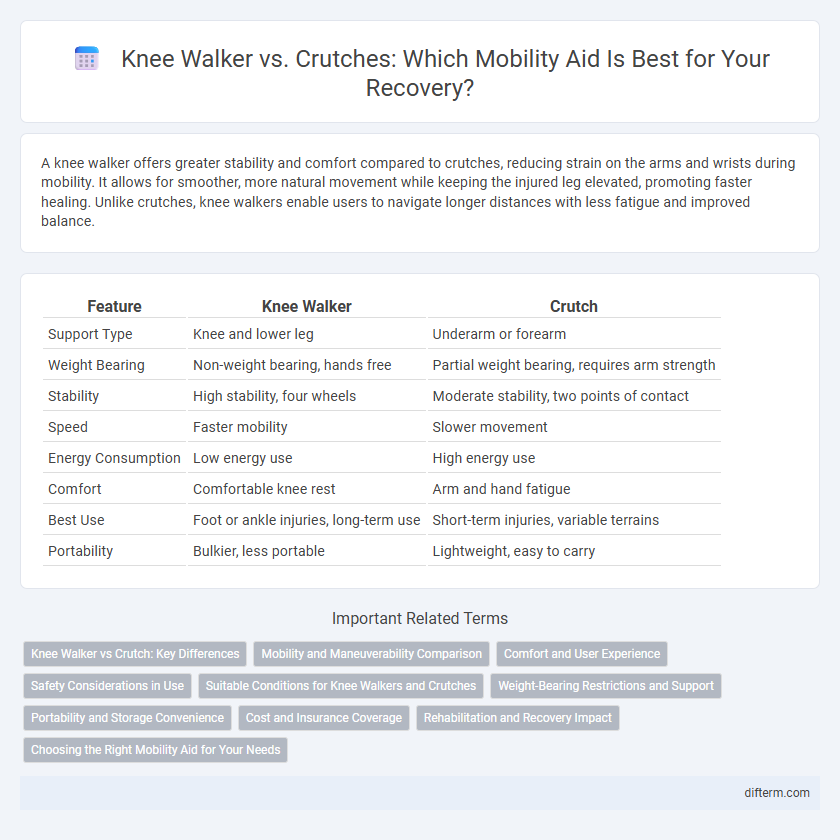A knee walker offers greater stability and comfort compared to crutches, reducing strain on the arms and wrists during mobility. It allows for smoother, more natural movement while keeping the injured leg elevated, promoting faster healing. Unlike crutches, knee walkers enable users to navigate longer distances with less fatigue and improved balance.
Table of Comparison
| Feature | Knee Walker | Crutch |
|---|---|---|
| Support Type | Knee and lower leg | Underarm or forearm |
| Weight Bearing | Non-weight bearing, hands free | Partial weight bearing, requires arm strength |
| Stability | High stability, four wheels | Moderate stability, two points of contact |
| Speed | Faster mobility | Slower movement |
| Energy Consumption | Low energy use | High energy use |
| Comfort | Comfortable knee rest | Arm and hand fatigue |
| Best Use | Foot or ankle injuries, long-term use | Short-term injuries, variable terrains |
| Portability | Bulkier, less portable | Lightweight, easy to carry |
Knee Walker vs Crutch: Key Differences
Knee walkers offer enhanced stability and reduced upper body strain compared to crutches, providing a more comfortable alternative for individuals with lower leg injuries. Unlike crutches, which require significant arm strength and can cause wrist fatigue, knee walkers allow the user to rest the injured leg on a padded platform, facilitating easier mobility and better balance. This difference makes knee walkers particularly suitable for longer recovery periods and indoor as well as outdoor use.
Mobility and Maneuverability Comparison
Knee walkers offer superior mobility by allowing users to maintain a natural walking motion with hands free for tasks, resulting in smoother maneuverability over various terrains compared to crutches. Crutches require upper body strength and coordination, often limiting speed and causing fatigue, which can reduce overall mobility efficiency. Knee walkers enhance stability and balance, making them ideal for longer distances and varied indoor or outdoor environments.
Comfort and User Experience
Knee walkers offer superior comfort compared to crutches by providing a cushioned platform that reduces strain on the wrists and hands, allowing users to travel longer distances with less fatigue. The ergonomic design of knee walkers promotes better posture and balance, enhancing overall user experience and reducing the risk of secondary injuries. In contrast, crutches often cause discomfort due to underarm pressure and require significant upper body strength, making knee walkers a preferred option for extended mobility support.
Safety Considerations in Use
Knee walkers provide enhanced stability by supporting the lower leg and reducing upper body strain, lowering the risk of falls compared to crutches. Crutches require significant upper body strength and coordination, increasing the chance of slips or muscle fatigue. Proper adjustment and user training are essential for both devices to maximize safety during mobility.
Suitable Conditions for Knee Walkers and Crutches
Knee walkers are ideal for individuals with non-weight-bearing lower leg or foot injuries, providing stability and comfort during extended use. Crutches are better suited for short-term mobility challenges or cases requiring upper body strength, offering versatility across various injuries. Choosing between the two depends on the injury type, duration of use, and user's physical strength and balance.
Weight-Bearing Restrictions and Support
Knee walkers provide enhanced weight-bearing support by allowing users to rest the injured leg on a padded platform, reducing strain on the upper body and improving mobility for those with partial or non-weight-bearing restrictions. Crutches require upper body strength to bear weight through the hands and arms, which can cause fatigue and discomfort during prolonged use, potentially limiting mobility for individuals with limited upper body strength. Choosing a knee walker over crutches can facilitate safer weight distribution and stability, especially for patients needing to keep pressure off the lower extremity.
Portability and Storage Convenience
Knee walkers offer enhanced portability with compact frames that fold easily, making them ideal for storage in small spaces or car trunks. Crutches, while lightweight, can be cumbersome to carry long distances and lack convenient folding mechanisms for compact storage. Users seeking a combination of ease in transport and efficient storage often find knee walkers more practical than traditional crutches.
Cost and Insurance Coverage
Knee walkers typically cost between $70 and $150, whereas crutches range from $20 to $40, making crutches the more budget-friendly option upfront. Insurance coverage for knee walkers varies but often requires a prescription and may cover a significant portion of the cost, while crutches are generally covered under basic durable medical equipment benefits. Patients should verify with their insurance provider to understand eligibility and reimbursement policies for both mobility aids.
Rehabilitation and Recovery Impact
Knee walkers provide enhanced stability and reduce upper body strain compared to crutches, promoting faster rehabilitation and improved mobility during recovery. Patients using knee walkers experience decreased risk of secondary injuries and greater comfort, facilitating consistent use and adherence to mobility protocols. Crutches often lead to increased fatigue and pressure on the wrists and shoulders, which can hinder effective rehabilitation and prolong recovery time.
Choosing the Right Mobility Aid for Your Needs
Knee walkers provide enhanced stability and comfort, reducing upper body strain compared to crutches, making them ideal for individuals with lower leg injuries requiring non-weight bearing support. Crutches offer greater portability and are suitable for varying terrains, but demand significant upper body strength and balance. Selecting the right mobility aid depends on injury type, physical capability, and lifestyle requirements to ensure optimal recovery and mobility.
Knee walker vs Crutch Infographic

 difterm.com
difterm.com